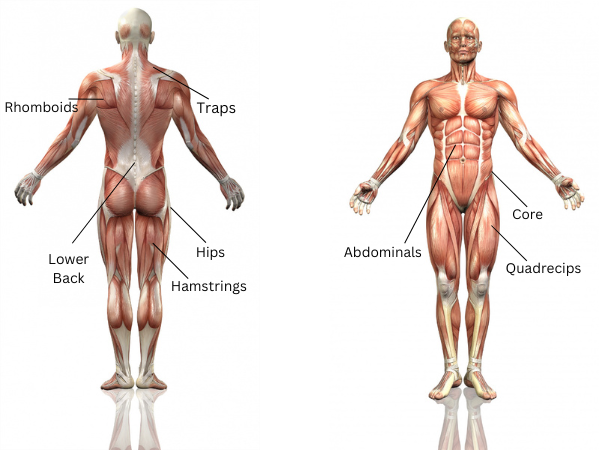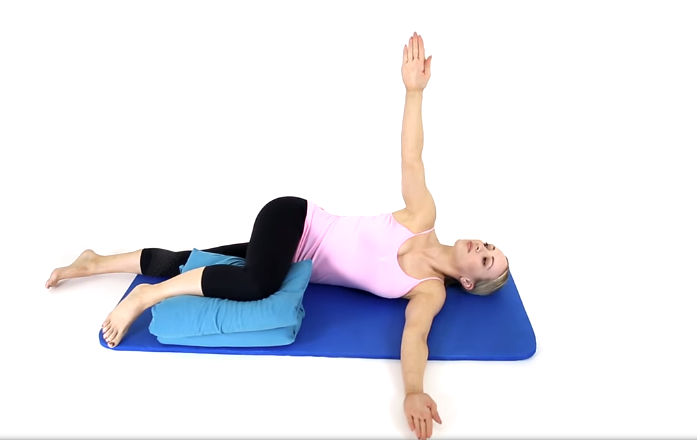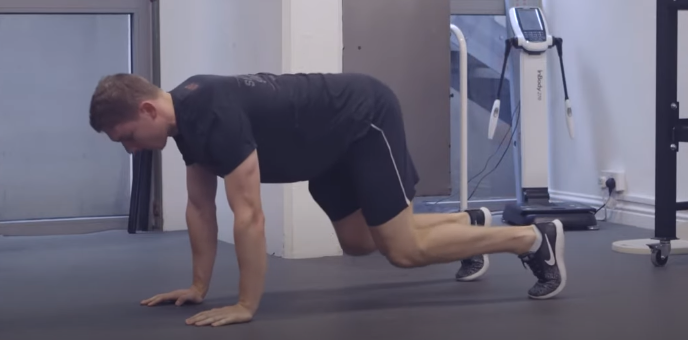Do you want to enhance your strength? Do you desire to build endurance and exercise your entire body without the need for extensive equipment? Absolutely! You’ll love the Kettlebell Swing.
It’s a powerful workout targeting various muscles, offering an energy boost and strength. I’ve always loved this exercise—it requires minimal space, few equipment, and no gym visit. The beauty lies in its effectiveness, surpassing many exercises in muscle strengthening.
In this guide, we’ll cover everything from how to perform it, common mistakes to avoid, to the benefits, and provide a suitable exercise routine for you.
In Short What Is Kettlebell Swings

The Kettlebell Swing is a fun and effective exercise where you swing a kettlebell back and forth.
It’s like a dynamic hip hinge that works many muscles, making you stronger and boosting your stamina. What’s great is, you don’t need much space or fancy equipment—just a kettlebell.
It’s a powerhouse exercise that’s simple yet super effective for building overall strength and energy. So, swing away and enjoy the benefits!
How To Kettlebell Swing
Starting Position:
- Stand with your feet shoulder-width apart or slightly wider. The kettlebell should be placed about a foot in front of you.
Hip Hinge:
- Hinge at your hips, pushing your hips back while maintaining a flat back. Your torso will lean forward, and your knees will bend slightly.
Grip the Kettlebell:
- Reach down and grip the kettlebell handle with both hands. Keep your arms straight, and your palms should be facing your body.
Engage Core Muscles:
- Brace your core by tightening your abdominal muscles. This provides stability to your spine.
Set Your Back:
- Keep your back flat and in a neutral position. Avoid rounding or arching your spine.
First Swing:
- Swing the kettlebell back between your legs. The power for the movement comes from the explosive hip extension.
Hip Thrust:
- Thrust your hips forward and stand tall. Allow the momentum to swing the kettlebell upward.
Shoulder Height:
- The kettlebell should swing up to about shoulder height. Your arms should be parallel to the ground.
Controlled Descent:
- Allow the kettlebell to descend back between your legs in a controlled manner. Your hips hinge back as the bell swings down.
Repeat:
- Repeat the hip-hinging movement, swinging the kettlebell back and forth in a smooth, controlled motion.
Pro Tips
- Focus on the power generated from your hips rather than using your arms to lift the kettlebell.
- Maintain a straight back throughout the movement.
- Keep the movement fluid and controlled. Avoid hyperextending your back.
- Start with a lighter weight to master the form before progressing to heavier kettlebells.
Muscle Worked

1. Power Players:
- Glutes and hamstrings take the lead, driving the explosive hip thrust that powers each swing.
2. Core Stabilizers:
- Abs and lower back work in tandem, ensuring a stable spine throughout the dynamic movement.
3. Back Support:
- Upper and lower back muscles provide crucial support, maintaining proper spinal alignment.
4. Shoulder Assist:
- Shoulders and traps play a supporting role, controlling the kettlebell’s upward trajectory.
5. Arm Guides:
- Arms act as guides, maintaining a straight path for the kettlebell without being the main lifters.
6. Cardio Contributors:
- The continuous swinging motion engages the cardiovascular system, adding a cardio element to the workout.
7. Leg Stability:
- Quads and calves contribute to lower-body stability, enhancing the overall effectiveness of the swing.
Kettlebell swing Mistakes
1. Squatting Instead of Hinging:
- Fix: Focus on the hip hinge, pushing the hips back and maintaining a straight back to engage the posterior chain.
2. Overarching the Lower Back:
- Fix: Keep a neutral spine throughout, avoiding hyperextension. Engage the core to protect the lower back.
3. Using Too Much Arm Strength:
- Fix: Let the hips propel the swing; arms should guide, not lift.
4. Neglecting Core Engagement:
- Fix: Tighten the core as if preparing for a punch, providing a stable foundation for the swing.
5. Lack of Control on Descent:
- Fix: Maintain control as the kettlebell descends, actively engaging the hips and controlling the movement.
6. Insufficient Hip Thrust:
- Fix: Emphasize the explosive hip thrust to maximize power and momentum.
7. Overreliance on Momentum:
- Fix: Stay in control throughout the swing, avoiding overreliance on momentum for a safer and more effective workout.
8. Poor Foot Placement:
- Fix: Keep the feet planted firmly, pointing slightly outward, maintaining a stable and comfortable stance.
9. Using a Heavy Kettlebell Initially:
- Fix: Begin with a lighter weight to master technique before progressing to heavier kettlebells.
10. Not Paying Attention to Breathing:
- Fix: Establish a rhythmic breathing pattern, exhaling forcefully during the hip thrust and inhaling during the descent.
Benefits Of Kettlebell Swing
Full-Body Conditioning:
- Kettlebell swings engage multiple muscle groups simultaneously, providing a comprehensive workout for the entire body. This efficiency contributes to improved strength and endurance.
Cardiovascular Endurance:
- The dynamic and continuous nature of kettlebell swings elevates the heart rate, turning the exercise into a cardiovascular workout. This dual benefit makes it an excellent choice for those seeking both strength and cardio improvements.
Explosive Hip Power:
- The hip hinge and explosive hip thrust in kettlebell swings enhance power development in the hips and posterior chain. This not only improves athletic performance but also contributes to functional strength in daily activities.
Time-Efficient Workouts:
- Kettlebell swings offer a time-efficient solution for busy individuals. In just a few minutes, you can achieve a high-intensity workout that targets multiple fitness components, making it ideal for those with limited time.
Fat Loss and Metabolic Boost:
- The combination of strength training and cardiovascular elements in kettlebell swings makes them effective for fat loss. Additionally, the metabolic demand created by this exercise can lead to increased calorie burning, supporting weight management goals.
How To Pick The Right Weight For Kettlebell Swing
Choosing an appropriate kettlebell weight is crucial; it plays a fundamental role in the exercise’s quality, helping you control the movement path and preventing injuries.
So keep this in mind :
Beginner:
- Men: Start with 8-12 kg (18-26 lbs).
- Women: Begin with 4-8 kg (9-18 lbs).
Intermediate:
- Men: Progress to 16-20 kg (35-44 lbs).
- Women: Move up to 10-16 kg (22-35 lbs).
Advanced:
- Men: Use 24 kg (53 lbs) or more.
- Women: Utilize 16 kg (35 lbs) or more.
Athletic/Strong:
- Men: 32 kg (70 lbs) or more.
- Women: 20 kg (44 lbs) or more.
A Simple Workout Routine
Warm-Up:
- Jumping jacks: 3 minutes
- Bodyweight squats: 2 sets of 15 reps
- Arm circles: 2 sets of 1 minute each direction
Kettlebell Swing Workout:
Two-Handed Kettlebell Swings:
- Perform 3 sets of 15 reps.
- Rest for 30 seconds between sets.
Single-Arm Kettlebell Swings:
- Perform 3 sets of 12 reps on each arm.
- Rest for 30 seconds between sets.
Kettlebell American Swings:
- Perform 3 sets of 10 reps.
- Rest for 30 seconds between sets.
Cool Down:
- Forward bends: 2 sets of 1 minute
- Child’s pose: 2 sets of 1 minute
- Shoulder stretches: 2 sets of 30 seconds each arm
Kettlebell Swing Variations
1. Two-Handed Kettlebell Swing:
How to:
- Begin with your feet shoulder-width apart and the kettlebell on the ground between your legs.
- Hinge at the hips, keeping your back flat, and grasp the kettlebell with both hands.
- Swing the kettlebell back between your legs, then explosively drive your hips forward to propel the kettlebell to chest level.
- Allow the kettlebell to swing back down between your legs, maintaining a controlled motion.
- Repeat for the desired number of repetitions.
2. Single-Arm Kettlebell Swing:
How to:
- Set up in a similar stance as the two-handed swing with the kettlebell on the ground.
- This time, grip the kettlebell with one hand.
- Perform the swing as described in the two-handed version, focusing on hip drive and maintaining a straight back.
- Switch hands and repeat for an equal number of reps on each side.
3. Kettlebell American Swing:
How to:
- Start in the two-handed swing position but swing the kettlebell overhead rather than to chest level.
- As the kettlebell reaches its highest point, straighten your arms and extend the hips fully.
- Control the descent as the kettlebell swings back down and between your legs.
- Ensure your core is engaged to protect your lower back during the upward motion.
- Repeat for the desired number of reps.
FAQ
How heavy should my kettlebell be for swings?
Start light and focus on form. Beginners often begin with 8-12 kg for men and 4-8 kg for women.
Can I do kettlebell swings every day?
It’s not necessary. 2-3 times per week is sufficient to allow for recovery and prevent overtraining.
Are kettlebell swings good for weight loss?
Yes, they combine strength and cardio, making them effective for burning calories and promoting fat loss.
What’s the difference between American swings and Russian swings?
Russian swings go to chest level, while American swings go overhead. Choose based on your fitness goals and shoulder health.
Can kettlebell swings replace cardio workouts?
They provide a cardio benefit but shouldn’t replace dedicated cardio sessions. Use them as part of a well-rounded routine.
Related Articles
Battle Rope Slams The Most Powerful Exercise For Strength
Try Bear Squat For Max Gain Of Flexibility And Joint Mobility



